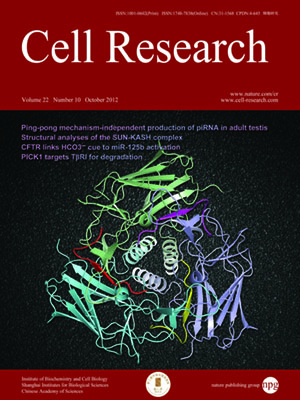
Volume 22, No 10, Oct 2012
ISSN: 1001-0602
EISSN: 1748-7838 2018
impact factor 17.848*
(Clarivate Analytics, 2019)
Volume 22 Issue 10, October 2012: 1467-1478
ORIGINAL ARTICLES
PICK1 promotes caveolin-dependent degradation of TGF-β type I receptor
Bing Zhao1, Qiang Wang1,4, Jun Du1, Shiwen Luo2, Jun Xia3 and Ye-Guang Chen1
1The State Key Laboratory of Biomembrane and Membrane Biotechnology, Tsinghua-Peking Center for Life Sciences, School of Life Sciences, Tsinghua University, Beijing 100084, China
2The First Affiliated Hospital, Nanchang University, Nanchang, Jiangxi 330006, China
3Department of Biochemistry, The Hong Kong University of Science and Technology, Clear Water Bay, Kowloon, Hong Kong, China
4Current address: Institute of Zoology, Chinese Academy of Sciences, Beijing 100101, China
Correspondence: Ye-Guang Chen,(ygchen@tsinghua.edu.cn)
Protein that interacts with C kinase 1 (PICK1) is a critical mediator of α-amino-3-hydroxy-5-methyl-4-isoxazolepropionic acid receptor (AMPAR) trafficking in neural synapses. However, its ubiquitous expression suggests that it may have other non-neural functions. Here we show that PICK1 antagonizes transforming growth factor beta (TGF-β) signaling by targeting TGF-β type I receptor (TβRI) for degradation. Biochemical analyses reveal that PICK1 directly interacts with the C-terminus of TβRI via its PDZ domain and acts as a scaffold protein to enhance the interaction between TβRI and caveolin-1, leading to enhanced lipid raft/caveolae localization. Therefore, PICK1 increases caveolin-mediated endocytosis, ubiquitination and degradation of TβRI. Moreover, a negative correlation between PICK1 expression and TβRI or phospho-Smad2 levels is observed in human breast tumors, indicating that PICK1 may participate in breast cancer development through inhibition of TGF-β signaling. Our findings reveal a non-neural function of PICK1 as an important negative regulator of TGF-β signaling.
Cell Research (2012) 22:1467-1478. doi:10.1038/cr.2012.92; published online 19 June 2012
FULL TEXT | PDF
Browse 2477


